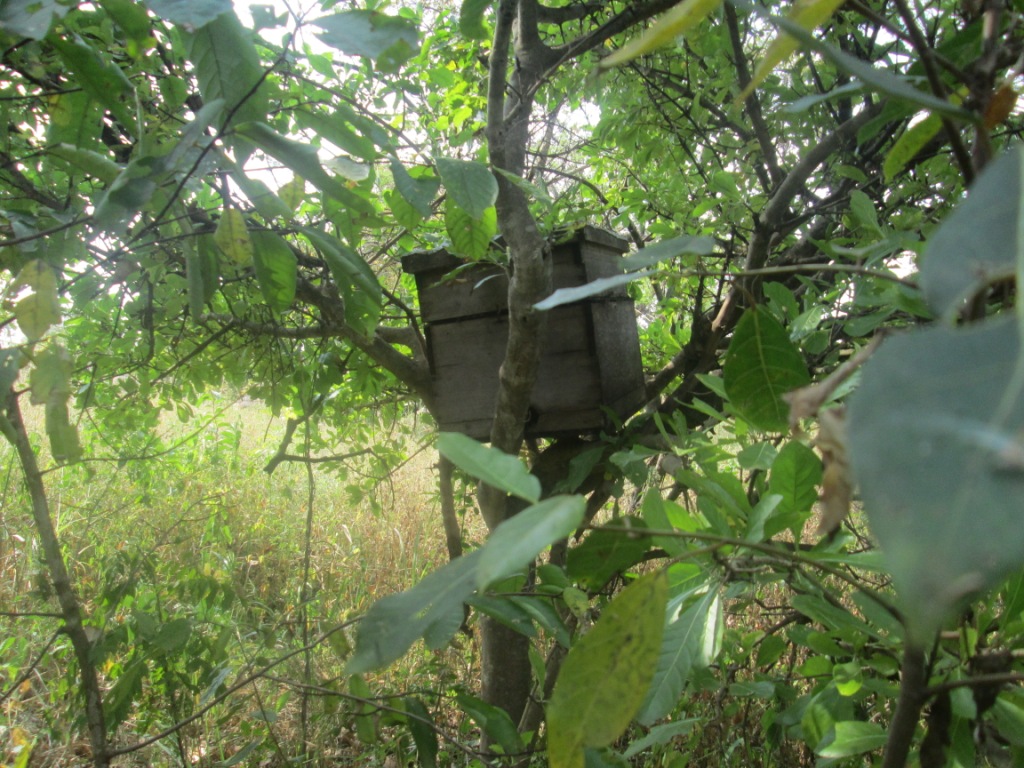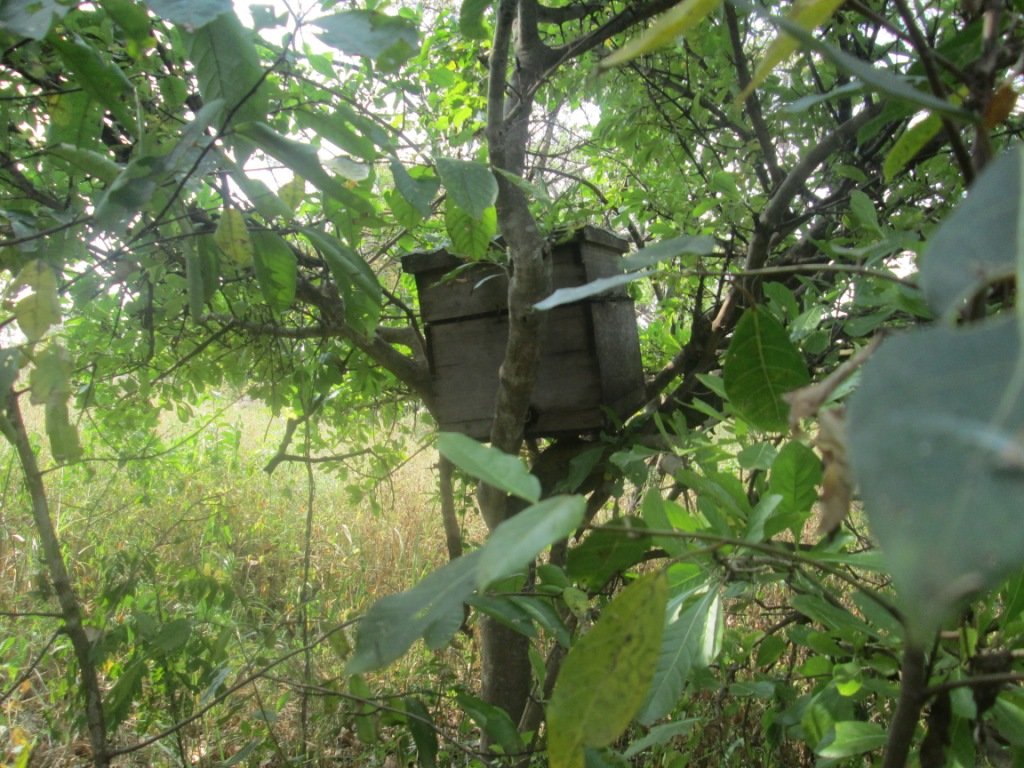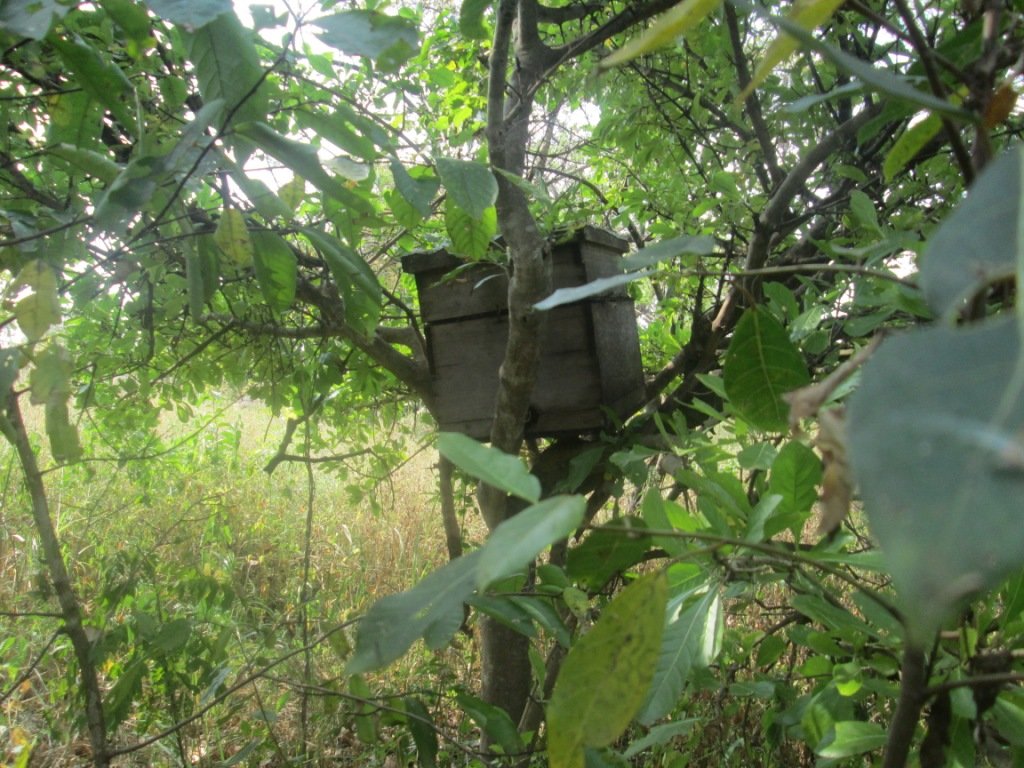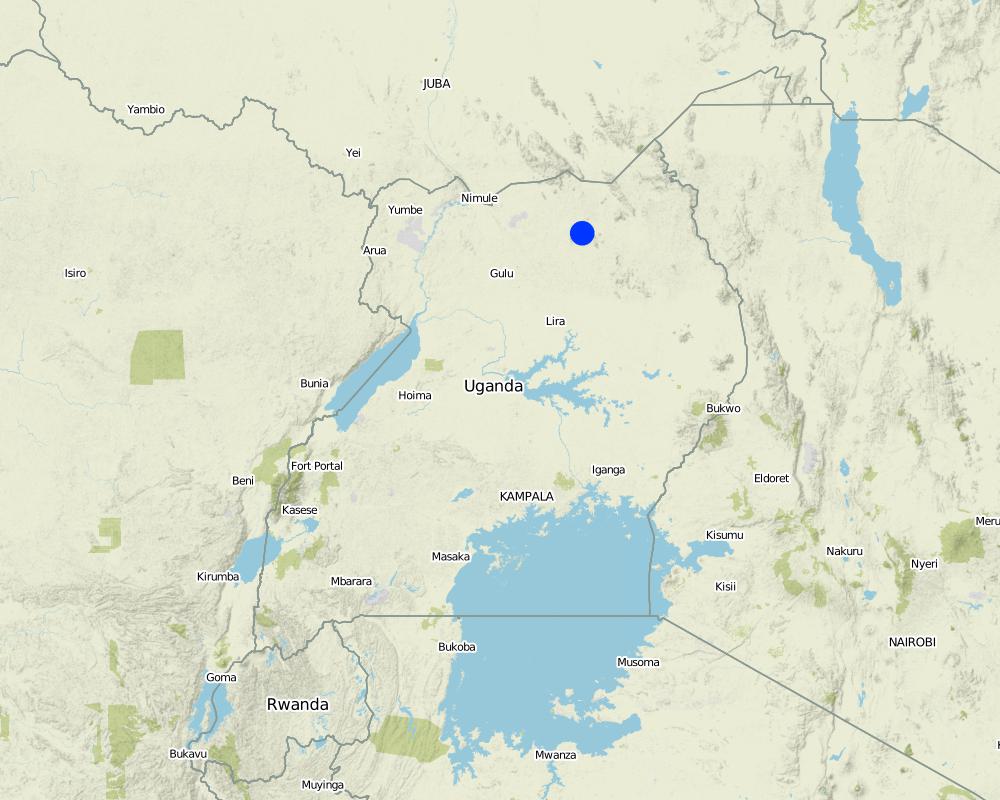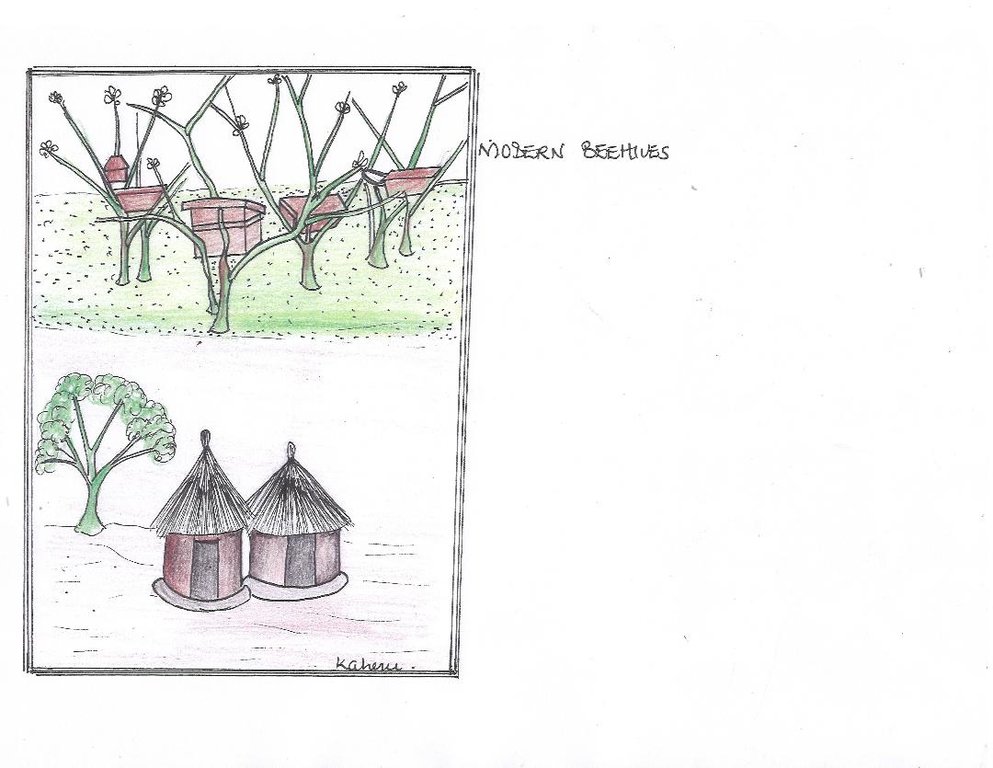Modern Bee Hives based Apiculture [乌干达]
- 创建:
- 更新:
- 编制者: Kamugisha Rick Nelson
- 编辑者: JOY TUKAHIRWA, Richard Otto Kawawa, Bernard Fungo, betty adoch
- 审查者: Drake Mubiru, Nicole Harari, Renate Fleiner, Stephanie Jaquet, Donia Mühlematter
Pito Kil
technologies_2327 - 乌干达
查看章节
全部展开 全部收起1. 一般信息
1.2 参与该技术评估和文件编制的资源人员和机构的联系方式
关键资源人
土地使用者:
OKeny Oris
0782595646
ocanbosco@yahoo.com
Kitgum District
Kitgum District
乌干达
有助于对技术进行记录/评估的项目名称(如相关)
Scaling-up SLM practices by smallholder farmers (IFAD)有助于对技术进行记录/评估的机构名称(如相关)
CDE Centre for Development and Environment (CDE Centre for Development and Environment) - 瑞士1.3 关于使用通过WOCAT记录的数据的条件
(现场)数据是什么时候汇编的?:
12/05/2017
编制者和关键资源人员接受有关使用通过WOCAT记录数据的条件。:
是
1.4 所述技术的可持续性声明
这里所描述的技术在土地退化方面是否存在问题,导致无法被认为是一种可持续的土地管理技术?:
否
注释:
The protected vegetation where the bees are installed restores the environment since its not cultivated over and over again.
2. SLM技术的说明
2.1 技术简介
技术定义:
Modern bee hives are installed on natural trees in order to conserve the environment and provide honey and income.
2.2 技术的详细说明
说明:
Apiculture is a non-problematic enterprise promoted by small-scale farmers. Beehives are hanged by the land user on trees for purposes of conservation and obtaining income from the sale of honey. The technology is located on a gentle slope (3-5%) of 3 acres of land with 150 bee hives installed. The trees produce flowers from which bees collect nectar to make honey. The activities involved in the establishment include making or acquiring improved beehives, installing the hives, and buying honey-harvesting equipment. In addition, there are maintenance activities which are; the inspection of the hives for damages, repair of damaged hives, periodic harvesting of honey, clearing overgrowth within the apiary and marketing the honey. The inputs required for establishing such a technology include labour for bush clearing, placing the beehives within trees and construction of fire lines. Other inputs are beehives, a bee suit, smoker, bucket, filtering materials and bottles. These inputs require a lot of money. The benefits from this SLM technology are slightly negative due to the high costs of labour at the time of establishment but positive in the long term due to environmental conservation, provision of honey and income from the sale of honey and to some extent reduction in land cover depletion since no cultivation takes place where the bee hives are installed. The bees also play an important role in the well being of the ecosystem through pollinating flowers of plants within their reach.
The technology is easy to manage once established, because it does not require routine activities like weeding, spraying and watering. For other land users who may need to adopt this technology, they need to seek advice from extension agents on how to install the beehives.
2.3 技术照片
2.4 技术视频
注释、简短说明:
Modern bee hives based apiculture ,Kitgum District, Northern Uganda.
日期:
27/04/2017
位置:
Kitgum District
摄影师的名字:
Issa Aiga
2.5 已应用该技术的、本评估所涵盖的国家/地区/地点
国家:
乌干达
区域/州/省:
Northern Region,Uganda
有关地点的进一步说明:
Kitgum District
注释:
Map showing technology site in Northern Uganda.
Map
×2.6 实施日期
注明实施年份:
2013
如果不知道确切的年份,请说明大概的日期:
- 不到10年前(最近)
2.7 技术介绍
详细说明该技术是如何引入的:
- 通过土地使用者的创新
- 作为传统系统的一部分(> 50 年)
注释(项目类型等):
The land user started on his own and later he got support with trainings from other development programs e.g. the Northern Uganda Social Action Fund (NUSAF) and Operation Wealth Creation (OWC) / NAADS (National Agricultural Advisory Services).
3. SLM技术的分类
3.1 该技术的主要目的
- 改良生产
- 减少、预防、恢复土地退化
- 保护生态系统
- 适应气候变化/极端天气及其影响
- 创造有益的经济影响
3.2 应用该技术的当前土地利用类型

森林/林地
(半天然)天然森林/林地:
- 清除枯木/剪枝
产品和服务:
- 其它森林产品
- Honey

混合(作物/放牧/树木),包括农林
- 农林业
3.3 有关土地利用的更多信息
该技术所应用土地的供水:
- 雨养
每年的生长季节数:
- 2
具体说明:
August and March. Depending on the season.
3.4 该技术所属的SLM组
- 农业林学
- 养蜂、养殖业、家禽业、养兔业、养蚕业等
3.5 技术传播
具体说明该技术的分布:
- 均匀地分布在一个区域
如果该技术均匀地分布在一个区域上,请注明覆盖的大致区域。:
- < 0.1 平方千米(10 公顷)
注释:
The land user is utilizing 3 acres of land currently for apiary.
3.6 包含该技术的可持续土地管理措施

结构措施
- S11:其它

管理措施
- M2:改变管理/强度级别
- M3:根据自然和人文环境进行布局
注释:
The land user is establishing fire lines to keep away wild bush fires and making regular inspection of bee hives.
3.7 该技术强调的主要土地退化类型

生物性退化
- Bc:植被覆盖的减少
- Bh:栖息地丧失
- Bf:火灾的有害影响
3.8 防止、减少或恢复土地退化
具体数量名该技术与土地退化有关的目标:
- 适应土地退化
4. 技术规范、实施活动、投入和成本
4.1 该技术的技术图纸
4.2 技术规范/技术图纸说明
The technology is installed on a gentle slope (3-5%) located on a 3 acres of land with 150 bee hives.
4.3 有关投入和成本计算的一般信息
具体说明成本和投入是如何计算的:
- 每个技术区域
注明尺寸和面积单位:
3 acres
其它/国家货币(具体说明):
UGX
注明美元与当地货币的汇率(如相关):1美元=:
3400.0
注明雇用劳工的每日平均工资成本:
5000 per person per day
4.4 技术建立活动
| 活动 | 措施类型 | 时间 | |
|---|---|---|---|
| 1. | Installing bee hives location | 结构性的 | Once before establishment, |
| 2. | Construction of hives (traditional and modern) | 结构性的 | Before establishment |
| 3. | Place hives on forests or trees | 结构性的 | Before establishment |
4.5 技术建立所需要的费用和投入
| 对投入进行具体说明 | 单位 | 数量 | 单位成本 | 每项投入的总成本 | 土地使用者承担的成本% | |
|---|---|---|---|---|---|---|
| 劳动力 | Hired labour (installation) | persons | 5.0 | 5000.0 | 25000.0 | |
| 设备 | Bee hives | Pieces | 16.0 | 90000.0 | 1440000.0 | |
| 其它 | Transport | pick up | 1.0 | 20000.0 | 20000.0 | |
| 技术建立所需总成本 | 1485000.0 | |||||
注释:
Modern hives are more expensive than local hives.
4.6 维护/经常性活动
| 活动 | 措施类型 | 时间/频率 | |
|---|---|---|---|
| 1. | Clearing around the apiary | 管理 | Once a year |
| 2. | Hive inspection | 管理 | After every two weeks |
| 3. | Repair of damaged hives | 结构性的 | Once after 2 years |
| 4. | Regular checking of hives | 管理 | Regularly |
| 5. | Filter honey from curbs to seprate wax | 管理 | At the time of harvesting |
4.7 维护/经常性活动所需要的费用和投入(每年)
| 对投入进行具体说明 | 单位 | 数量 | 单位成本 | 每项投入的总成本 | 土地使用者承担的成本% | |
|---|---|---|---|---|---|---|
| 劳动力 | Hired labour | persons | 5.0 | 5000.0 | 25000.0 | |
| 设备 | Timber | Pieces | 2.0 | 10000.0 | 20000.0 | |
| 设备 | Nails | kgs | 2.0 | 7000.0 | 14000.0 | |
| 设备 | Wires | kgs | 100.0 | 2000.0 | 200000.0 | |
| 设备 | buckets | Pieces | 5.0 | 15000.0 | 75000.0 | |
| 技术维护所需总成本 | 334000.0 | |||||
4.8 影响成本的最重要因素
描述影响成本的最决定性因素:
Modern bee hives are the most expensive and the costs of labour.
5. 自然和人文环境
5.1 气候
年降雨量
- < 250毫米
- 251-500毫米
- 501-750毫米
- 751-1,000毫米
- 1,001-1,500毫米
- 1,501-2,000毫米
- 2,001-3,000毫米
- 3,001-4,000毫米
- > 4,000毫米
指定年平均降雨量(若已知),单位为mm:
1350.00
农业气候带
- 半湿润
5.2 地形
平均坡度:
- 水平(0-2%)
- 缓降(3-5%)
- 平缓(6-10%)
- 滚坡(11-15%)
- 崎岖(16-30%)
- 陡峭(31-60%)
- 非常陡峭(>60%)
地形:
- 高原/平原
- 山脊
- 山坡
- 山地斜坡
- 麓坡
- 谷底
垂直分布带:
- 0-100 m a.s.l.
- 101-500 m a.s.l.
- 501-1,000 m a.s.l.
- 1,001-1,500 m a.s.l.
- 1,501-2,000 m a.s.l.
- 2,001-2,500 m a.s.l.
- 2,501-3,000 m a.s.l.
- 3,001-4,000 m a.s.l.
- > 4,000 m a.s.l.
说明该技术是否专门应用于:
- 凹陷情况
5.3 土壤
平均土层深度:
- 非常浅(0-20厘米)
- 浅(21-50厘米)
- 中等深度(51-80厘米)
- 深(81-120厘米)
- 非常深(> 120厘米)
土壤质地(表土):
- 中粒(壤土、粉土)
土壤质地(地表以下> 20厘米):
- 中粒(壤土、粉土)
- 细粒/重质(粘土)
表土有机质:
- 中(1-3%)
5.4 水资源可用性和质量
地下水位表:
< 5米
地表水的可用性:
中等
水质(未处理):
良好饮用水
水的盐度有问题吗?:
否
该区域正在发生洪水吗?:
否
关于水质和水量的注释和进一步规范:
The quality is good: land user uses bore hole water.
5.5 生物多样性
物种多样性:
- 低
栖息地多样性:
- 低
5.6 应用该技术的土地使用者的特征
定栖或游牧:
- 定栖的
生产系统的市场定位:
- 混合(生计/商业
非农收入:
- 低于全部收入的10%
相对财富水平:
- 平均水平
个人或集体:
- 个人/家庭
- 团体/社区
机械化水平:
- 手工作业
性别:
- 男人
土地使用者的年龄:
- 中年人
- 老年人
说明土地使用者的其他有关特征:
The land user is a hard working farmer and he is planning to plant trees in addition to the apiary technology and to start livestock (zero grazing) for animal manure production. The land user uses rudimentary tools (hoe, panga) for his agricultural production.
5.7 应用该技术的土地使用者拥有或租用的平均土地面积
- < 0.5 公顷
- 0.5-1 公顷
- 1-2 公顷
- 2-5公顷
- 5-15公顷
- 15-50公顷
- 50-100公顷
- 100-500公顷
- 500-1,000公顷
- 1,000-10,000公顷
- > 10,000公顷
这被认为是小规模、中规模还是大规模的(参照当地实际情况)?:
- 中等规模的
注释:
The land user has another apiary site which is not near the documented one under this questionare (0.5 acres).
5.8 土地所有权、土地使用权和水使用权
土地所有权:
- 个人,未命名
土地使用权:
- 个人
用水权:
- 自由进入(无组织)
注释:
The water is low during the dry season.
5.9 进入服务和基础设施的通道
健康:
- 贫瘠
- 适度的
- 好
教育:
- 贫瘠
- 适度的
- 好
技术援助:
- 贫瘠
- 适度的
- 好
就业(例如非农):
- 贫瘠
- 适度的
- 好
市场:
- 贫瘠
- 适度的
- 好
能源:
- 贫瘠
- 适度的
- 好
道路和交通:
- 贫瘠
- 适度的
- 好
饮用水和卫生设施:
- 贫瘠
- 适度的
- 好
金融服务:
- 贫瘠
- 适度的
- 好
- 贫瘠
- 适度的
- 好
6. 影响和结论性说明
6.1 该技术的现场影响
社会经济效应
生产
土地管理
注释/具体说明:
No roaming animals and the technology allows vegetation growth.
收入和成本
农业投入费用
注释/具体说明:
Reduce in the short run but increase in the long run(at the time of harvest)
农业收入
注释/具体说明:
Decrease in the short run at the time of establishment and relaised in the long run at the time of harvest.
收入来源的多样性
注释/具体说明:
especially at the time of establishment and before harvest
工作量
生态影响
土壤
土壤水分
土壤覆盖层
注释/具体说明:
Due to litter from the tree leaves.
土壤流失
生物多样性:植被、动物
植被覆盖
注释/具体说明:
No cultivation taking place where the bee hives are cited.
植物多样性
有益物种
6.2 该技术的场外影响已经显现
对邻近农田的破坏
注释/具体说明:
protected.
6.3 技术对渐变气候以及与气候相关的极端情况/灾害的暴露和敏感性(土地使用者认为的极端情况/灾害)
渐变气候
渐变气候
| 季节 | 气候变化/极端天气的类型 | 该技术是如何应对的? | |
|---|---|---|---|
| 年温度 | 增加 | 适度 | |
| 季节性温度 | 湿季/雨季 | 增加 | 适度 |
| 年降雨量 | 减少 | 适度 | |
| 季雨量 | 湿季/雨季 | 减少 | 适度 |
气候有关的极端情况(灾害)
气候灾害
| 该技术是如何应对的? | |
|---|---|
| 干旱 | 适度 |
6.4 成本效益分析
技术收益与技术建立成本相比如何(从土地使用者的角度看)?
短期回报:
轻度消极
长期回报:
稍微积极
技术收益与技术维护成本/经常性成本相比如何(从土地使用者的角度看)?
短期回报:
轻度消极
长期回报:
稍微积极
注释:
At start the costs of establishment are high and reduce with time instead reaps alot of profits from the sales.
6.5 技术采用
- 1-10%
在所有采用这项技术的人当中,有多少人是自发地采用该技术,即未获得任何物质奖励/付款?:
- 0-10%
注释:
In the short run, the technology requires money to purchase modern bee hives at a costs of UGX 150,000 each.
6.6 适应
最近是否对该技术进行了修改以适应不断变化的条件?:
是
若是,说明它适应了哪些变化的条件:
- 不断变化的市场
具体说明技术的适应性(设计、材料/品种等):
The land user started with local bee hives- later adopted use of modern bee hives from NAAD's.
6.7 该技术的优点/长处/机会
| 土地使用者眼中的长处/优势/机会 |
|---|
| Source of income with good market locally. |
| Its a source of employment for family members and those in the community. |
| Easy to manage once established. Does not have routine activities like weeding, spraying and watering. There for easy to manage. |
| Can be easily replicated by other land users with less or similar size of land else where. |
| 编制者或其他关键资源人员认为的长处/优势/机会 |
|---|
| The technology does not require alot of labour once established. |
6.8 技术的弱点/缺点/风险及其克服方法
| 土地使用者认为的弱点/缺点/风险 | 如何克服它们? |
|---|---|
| The apiary is near home stead and bees can bite people. | Relocating some bee hives which are too near. |
| 编制者或其他关键资源人员认为的弱点/缺点/风险 | 如何克服它们? |
|---|---|
| The technology is a long term benefit: The land user need to Integrate other SLM practices for quick income | promoting zero grazing for manure and other products. |
7. 参考和链接
7.1 信息的方法/来源
- 实地考察、实地调查
01
- 与土地使用者的访谈
01
链接和模块
全部展开 全部收起链接
无链接
模块
无模块


